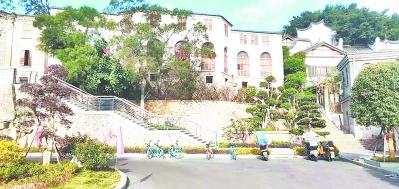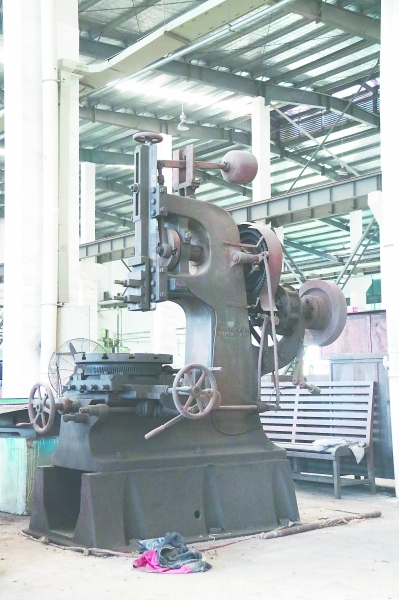Mawei: Leading the dream of reviving the shipbuilding culture
2020-04-02 15:11:04
This year marks the 200th anniversary of the birth of the shipbuilding predecessor Shen Baozhen, and the 44th session of the World Heritage Committee to be held in Fuzhou. Mawei District of Fuzhou City is strengthening the protection and restoration of shipbuilding relics, and launching various intangible cultural and natural heritage promotion activities to promote the inheritance of living heritages ——
Reporter: Wu Xutao Correspondents: Wang Xiaoxia Ruan Binbin Text / Photo

▲The environment around the intangible cultural heritage and special cultural exhibition hall has been completely renovated.

▲The old-style "slotting machine" survived nearly one hundred and fifty years of countless hardships.
“father of shipbuilding in China” stays alive in history
Recently, a symposium to commemorate Shen Baozhen’s 200th birthday anniversary and the book launching ceremony of the book titled From Shipbuilding to the Southern and Northern Seas – Naval defense in the late-Qing era as depicted by correspondences between Shen Baozhen and Li Hongzhang were held at the Mawei Shipbuilding Gezhi Park. Experts from all over the country engaged in discussions around Shen Baozhen and the shipbuilding culture, and the entire cover for “Commemorating the 200th Anniversary of Shen Baozhen's Birthday” was issued simultaneously.
As one of the founders of China's modern shipbuilding, shipping industry, and naval development, Shen Baozhen was the first Director-General of the Foochow (Fuzhou) Navy Yard in the Qing Dynasty and was hailed as the “father of shipbuilding in China”.
“As the descendants of Shen Baozhen, my generation has the honor of celebrating the 200th anniversary of the birth of our ancestor and we are so lucky to cherish the memory of our ancestor on this special day,” said Shen Yuan, the sixth-generation granddaughter of Shen Baozhen. The Foochow Shipbuilding Institution hosted by Shen Baozhen had exerted far-reaching influences on social, political, economic, military, cultural, and technological development. His educational concepts for his descendants has the same continuation with the idea of shipping administration education, which is, to read good books, be a good person, and spread the descendants with integrity and incorruptibility. "Under the influence of our ancestor's career in shipping administration, there were more than 20 persons of the Shen family who graduated from the Foochow Shipbuilding Institution and worked in shipping administration and the Navy of the Republic of China."
The book titled From Shipbuilding to the Southern and Northern Seas – Naval defense in the late-Qing era as depicted by correspondences between Shen Baozhen and Li Hongzhang launched during the ceremony, vividly presented the history of coastal defense development in the late Qing Dynasty from the level of private letters between two late Qing high-ranking officials and displayed the difficulties of modern China's coastal defense development.
"This book has compiled and included a total of 134 answer-and-reply letters between Shen Baozhen and Li Hongzhang. Each letter is checked and proofread, and the personages, events, and historical background involved in the letters undergo textual research, which proved from another perspective that Li Hongzhang was also under the influence of Shen Baozhen. This is something that has been neglected in previous studies." Said Chen Yue, the author of the book and chairman of the Mawei Shipbuilding Culture Research Association.
As the 44th session of the World Heritage Committee will be held in Fuzhou this year, Mawei District is working hard to combine the shipbuilding culture with the local intangible cultural and natural heritages, making it a highlight of the session.
“When the 44th session of the World Heritage Committee is held, local dramas such as Min Opera and Chichang Opera will be performed on this stage.”, A semi-open stage is being transformed into a special performance venue on old shipbuilding street in Mawei. Liu Hong, Chief of the Cultural Affairs Section of the Culture, Sports and Tourism Bureau of Mawei District, continued, “We have included the intangible cultural heritage as part of the shipbuilding relics, and prepared more than 20 special programs. The pre-arrangement of the programs is being carried out intensively.”
This reporter learned that to prepare for the 44th session of the World Heritage Committee, Mawei authorities have collected and arranged more than 30 children's rhymes, folk songs, and traditional stories, which will be displayed to the audience in major shipbuilding culture exhibition halls in the form of Min Operas, dance performances, and storytelling.
Return of the heavyweight monument
A few days ago, an old-style "slotting machine", about 1.8 meters high, weighing nearly 3 tons and engraved with French words and “1867”, returned from Sanming Machine Tool Plant to Fuzhou. During the 44th session of the World Heritage Committee, this “antique” will be exhibited as an important exhibit in China Shipbuilding Culture Museum.
“The protection of the shipbuilding industrial heritage involves all aspects, and the existing docks and berths are mostly buildings, while this 'slotting machine' is a production equipment.” Said Chen Yue, “Even in East Asia, such an old 'slotting machine' is extremely rare.”
Chen Yue emphasized that this machine is in very good condition. In fact, its official name is “straight planer”, and it represented the world's advanced level of machine tools and sophisticated designs in the 1860s. For example, the circular turntable at the bottom of the machine can improve work efficiency and processing accuracy.
This reporter also learned that the “slotting machine” survived the severe tests of the Sino-French Battle of Majiang and the resistance against Japanese aggression, and was transferred to Xiayang of Nanping; after the victory over Japanese aggression, it was returned to the rebuilt Mawei Navy Yard. In order to support the construction of Fujian Machinery Manufacturing Plant, the factory delivered a batch of machinery and equipment, including the “slotting machine” in the early 1970s; after that, Fujian Machinery Manufacturing Plant opened Sanming Machine Tool Plant in Shaxian County, and the old-style "slotting machine" was moved to Shaxian County where it was used for nearly half a century.
In October 2019, after a 27-day persuasion by the China Shipbuilding Culture Management Committee for taking away the machine, the old-style “slotting machine” safely returned to the former Navy Yard. Its successful return not only enriches the cultural relics of the shipbuilding culture, but also makes the 44th session of the World Heritage Committee more attractive.
Make a series of applications for entering the World Heritage list
At present, while preventing the spread of COVID-19 epidemic, Mawei District is making efforts to tap the shipbuilding culture to promote the construction of the "Mawei • China Shipbuilding Culture City", and on this basis, create a 5A national tourist attraction for shipbuilding culture.
This reporter learned that the China Shipbuilding Culture City consists of five major functional areas: the Guanjie zone, the former shipyard site, Maxianshan zone, Old Port zone, and Luoxing Pagoda zone. Among them, is the former shipyard site, covering an area of about 375 mu (about 25 hectares), which is focus on restoring some of its historic buildings, along with some local repairs, in order to reinvigorate and utilize the inheritance of shipbuilding culture through of the ship culture.
Taking the intangible cultural heritage and the special cultural exhibition hall under construction as an example, the exhibition hall is created within the Foochow Missionary Hospital of old shipbuilding street, which is itself a monument protected at the municipal level and is situated in the core protection area of the shipbuilding Culture City.
“We will transform the buildings without destroying the cultural relics, reflect the relationship between the exhibits of the exhibition hall and the core protection area of shipbuilding culture, and construct a profound panorama of historical culture from different angles and dimensions.” said Lin Hebin, Deputy Director of the Culture, Sports and Tourism Bureau of Mawei District.
The reporter learned that the exhibition hall will adapt to local conditions, and use the space resources of the shipbuilding historic and cultural block around the exhibition hall to carry out folklore reproduction activities for festival and holiday celebrations, so that the culture will move from static to live. The project is expected to be completed in mid-May 2020.
“At present, the construction of the shipbuilding agency including the front and rear schools inside the Gezhi Park, the old shipbuilding street, the shipbuilding characteristic historical and cultural district, and the Maxianshan overall improvement project have been completed,” said Han Qing, director of China Shipbuilding Culture Management Committee. He said that this historical site has a century-old turbine workshop, painting academy, bell tower and other cultural relics. In the future, Shipbuilding Gezhi Park, the historical buildings at the Navy Yard, the old shipbuilding street, the Shipbuilding Culture Museum, the Zhaozhong Temple and the Luoxing Pagoda will be connected to form a tourist attraction chain.
The reporter was informed that Mawei District is planning to apply for the inclusion of the shipbuilding culture in the world cultural heritage list, so as to better promote the inheritance of living heritage.